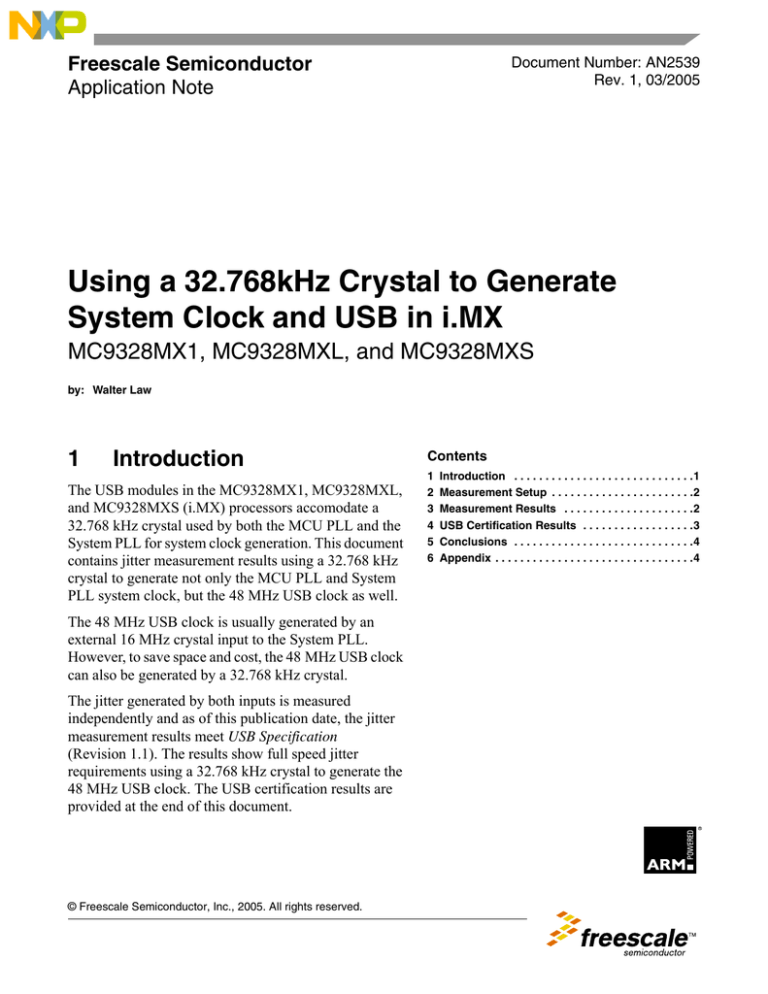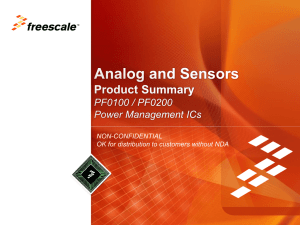
Freescale Semiconductor
Application Note
Document Number: AN2539
Rev. 1, 03/2005
Using a 32.768kHz Crystal to Generate
System Clock and USB in i.MX
MC9328MX1, MC9328MXL, and MC9328MXS
by: Walter Law
1
Introduction
The USB modules in the MC9328MX1, MC9328MXL,
and MC9328MXS (i.MX) processors accomodate a
32.768 kHz crystal used by both the MCU PLL and the
System PLL for system clock generation. This document
contains jitter measurement results using a 32.768 kHz
crystal to generate not only the MCU PLL and System
PLL system clock, but the 48 MHz USB clock as well.
The 48 MHz USB clock is usually generated by an
external 16 MHz crystal input to the System PLL.
However, to save space and cost, the 48 MHz USB clock
can also be generated by a 32.768 kHz crystal.
The jitter generated by both inputs is measured
independently and as of this publication date, the jitter
measurement results meet USB Specification
(Revision 1.1). The results show full speed jitter
requirements using a 32.768 kHz crystal to generate the
48 MHz USB clock. The USB certification results are
provided at the end of this document.
© Freescale Semiconductor, Inc., 2005. All rights reserved.
Contents
1
2
3
4
5
6
Introduction . . . . . . . . . . . . . . . . . . . . . . . . . . . . .1
Measurement Setup . . . . . . . . . . . . . . . . . . . . . . .2
Measurement Results . . . . . . . . . . . . . . . . . . . . .2
USB Certification Results . . . . . . . . . . . . . . . . . .3
Conclusions . . . . . . . . . . . . . . . . . . . . . . . . . . . . .4
Appendix . . . . . . . . . . . . . . . . . . . . . . . . . . . . . . . .4
Measurement Setup
2
Measurement Setup
The 48 MHz clock for the USB module in the i.MX processors is output to the CLKO pin by writing 0x010
to the CLKO_SEL bits [31:29] of the Clock Source Control Register. A Tektronix TDS7404 digital
oscilloscope was used to measure the clock jitter from the CLKO pin on the i.MX Application
Development System board (ADS).
The 48 MHz USB clock can be generated by either an external 16 MHz crystal input to System PLL, or
by a 32.768 kHz crystal. Independent measurements of USB clock jitter were taken using an external
16 MHz crystal as the source and a 32.768 kHZ crystal as the source to the System PLL.
The Clock Source Control Register settings that force output of the 48 MHz USB clock to CLKO pin and
for selecting either a 32.768 kHz crystal or 16 MHz crystal for System PLL are shown in Table 1.
Table 1. Clock Source Control Register Settings
3
Crystal Source for System PLL
Register Value
32.786 kHz
0x4700AC03
16 MHz
0x4743AC03
Measurement Results
Table 2 and Table 3 show the jitter measurement results.
Table 2. 48 MHz USB Clock Cycle to Cycle Jitter (MC9328MX1)
32.768 kHz Crystal Input to System PLL
MC9328MX1
Sample
16 MHz Crystal Input to System PLL
Mean
Standard Deviation
Mean
Standard
Deviation
Sample 1
78.577ps
78.061ps
53.180ps
62.871ps
Sample 2
42.265ps
46.839ps
44.647ps
54.500ps
Sample 3
37.854ps
45.054ps
50.21ps
68.534ps
Sample 4
37.247ps
47.666ps
57.488ps
68.098ps
Sample 5
36.751ps
43.071ps
37.961ps
46.288ps
Sample 6
59.435ps
69.435ps
63.224ps
68.27ps
Sample 7
41.756ps
49.371ps
40.353ps
50.153ps
Sample 8
33.747ps
39.792ps
37.749ps
50.972ps
Sample 9
44.191ps
53.187ps
47.298ps
54.892ps
Sample 10
67.917ps
70.497ps
68.339ps
67.360ps
Using a 32.768kHz Crystal to Generate System Clock and USB in i.MX Application Note, Rev. 1
2
Freescale Semiconductor
USB Certification Results
Table 3. 48 MHz USB Clock Cycle to Cycle Jitter (MC9328MXL)
MC9328MXL
Sample
32.768 kHz Crystal Input to System PLL
16 MHz Crystal Input to System PLL
Mean
Standard Deviation
Mean
Standard Deviation
Sample 1
51.248ps
77.737ps
44.985ps
62.388ps
Sample 2
57.679ps
80.717ps
58.09ps
77.656ps
Sample 3
61.789ps
86.31ps
56.239ps
84.976ps
Sample 4
90.048ps
75.384ps
53.653ps
70.263ps
Sample 5
111.07ps
86.314ps
93.813ps
78.693ps
Sample 6
54.392ps
75.725ps
51.183ps
70.409ps
Sample 7
94.043ps
61.543ps
64.125ps
91.549ps
Sample 8
87.243ps
78.685ps
83.926ps
77.376ps
Sample 9
126.37ps
92.748ps
64.923ps
92.584ps
Sample 10
63.332ps
92.516ps
62.27ps
90.343ps
Table 4. Cycle to Cycle Values (MC9328MX1/MC9328MXL)
MC9328MX1
32.768 kHz
16 MHz
Maximum cycle to cycle jitter mean value
78.577ps
68.339ps
Maximum cycle to cycle jitter standard deviation
78.061ps
68.534ps
32.768 kHz
16 MHz
Maximum cycle to cycle jitter mean value
126.37ps
93.813ps
Maximum cycle to cycle jitter standard deviation
92.748ps
92.584ps
MC9328MXL
4
USB Certification Results
The i.MX processor ADS can achieve USB certification using a 32.768 kHz crystal input to the MCU PLL
and System PLL for generation of the system clock and the 48 MHz USB clock. As of this publication
date, overall test results pass the current requirements. The USB certification results are provided at the
end of this document. The Table 5 and Figure 1 on page 4 highlight the individual test results regarding
signal quality.
Table 5. Jitter Measurement Results (Signal Quality and Eye Diagram)
Measurement Parameter
Signal eye:
Pass/Fail
Eye Passes
Measured signaling rate: 12.0028 MHz
Signal Rate Passes
E Receivers: reliable operation on tier 6
Receivers Pass
Using a 32.768kHz Crystal to Generate System Clock and USB in i.MX Application Note, Rev. 1
Freescale Semiconductor
3
Conclusions
Table 5. Jitter Measurement Results (Signal Quality and Eye Diagram) (continued)
Measurement Parameter
Consecutive jitter range: -0.2ns to 0.3ns RMS jitter 0.2ns
Paired JK jitter range: -0.1ns to 0.2ns, RMS jitter 0.1ns
Paired KJ jitter range: -0.3ns to 0.2ns, RMS jitter 0.2ns
EOP width: 167.77ns
Pass/Fail
Jitter Passes
EOP Width Passes
Figure 1. Jitter Measurement
5
Conclusions
1. There is no significant difference shown in jitter measurement results for the 48 MHz USB clock
generated by either a 32.768 kHz crystal or a 16 MHz crystal.
2. With a 32.768 kHz crystal generating both system clock and 48 MHz USB clock, the i.MX
processors pass the USB revision 1.1 requirements at full speed device test and can achieve USB
certification.
3. In view of broad space saving and cost minimization issues, Freescale recommends using a
32.768 kHz crystal used by the MCU PLL and System PLL to generate both the system clock and
the 48 MHz USB clock.
6
Appendix
Appendix attached: USB Certification Test Results
Using a 32.768kHz Crystal to Generate System Clock and USB in i.MX Application Note, Rev. 1
4
Freescale Semiconductor
NOTES
Using a 32.768kHz Crystal to Generate System Clock and USB in i.MX Application Note, Rev. 1
Freescale Semiconductor
5
Appendix
NSTL USB-IF PROGRAM
Test Report
NSTL Full & Low Speed Device
Test Report
Company Name:
Freescale Semiconductors
Hong Kong Ltd.
Model Name: DragonBall MX-1 ADS
Device Type: Non-hub device
Issue Date: 04/17/2003
Test Result: PASS
Using a 32.768kHz Crystal to Generate System Clock and USB in i.MX Application Note, Rev. 1
6
1/6
Freescale Semiconductor
Appendix
NSTL USB-IF PROGRAM
Test Report
USB-IF Pretest Report
Company
Company Name:
VID (Dec)
Freescale Semiconductors Hong Kong Ltd.
1061 The VID for the company who apply the USB-IF logo.
Technical Contact
Roy Leung
(852) 2666 8934
royleung@freescale.com
(852) 2615 9214
Name:
Phone Number:
E-Mail:
FAX Number:
Marketing Contact
Walter Law
(852) 26668293
Walter.Law@freescale.com
(852) 2615 9214
Name:
Phone Number:
E-Mail:
FAX Number:
Device Information:
Retail Device
Device Chipset
Hi Power
Low Power
Bus Powered
Self Powered
Full Speed
Low Speed
Untethered B
Tethered
Both
Device Class: Full speed
Device Name: DragonBall MX-1 ADS
Other:
Embedded Function:
VID: 1061
Tested O.S.
only.)
PID: 0001
Win98SE
Win2000 and/or
WinXP (Standard test fee will cover 1 OS
Tester: Eric Chen
Review: James Ou
Date:
04/17/2003
Over All Test Result: Pass
Using a 32.768kHz Crystal to Generate System Clock and USB in i.MX Application Note, Rev. 1
Freescale Semiconductor
2/6
7
Appendix
NSTL USB-IF PROGRAM
Test Report
Frameworks Test Result:
Chapter 9:
Pass
Pass
Fail
Fail HID View:
Pass
Fail
N/A
Interface: 1 MAX Power: 2 mA Remote Wakeup: N/A
Chapter 11:
Pass
Fail
Power Current Test Result:
N/A
Pass
HUB Port #:
Fail
Operating Power: 0 mA Unconfiguration Power: 0 mA (<100mA)
(<= Max Power <= 100mA for Low Power)
(<= Max Power <= 500mA for High Power)
(<=Max Power <= 100mA)
Configuration Power: 0 mA
Suspend Mode Power: 0 uA
(<= Max Power <= 100mA for Low Power)
(<= Max Power <= 500mA for High Power)
(<= 2500uA for High Power /w Remote Wake Up)
(<= 500uA x Port# for HUB) (<= 500uA for others)
Interoperability Test Result:
Pass
UHCI Controller:
Pass
Fail
EHCI Controller:
Pass
Fail
Signal Quality Test Result:
Up Stream SQ:
Pass
Fail OS:
OHCI Controller:
Pass
Fail
98SE
W2k
Pass
XP
Fail
Fail
Inrush Current:
Pass
Fail
Vdroop:
mV
(<= 100mA and 200uC)
Down Stream SQ:
Pass
Warning
Drop/ Droop Test Result:
Pass
For Self Powered HUB:
Vnon-load:
V Vload:
V
For BUS Powered HUB
Vupstream:
V Vdownstream:
Back Voltage Test :
D+: 62mV/ 0V
Pass
Fail
Vdrop:
(<=500mV)
N/A
N/A
V
V Vdrop:
(<=330mV)
V Vdroop:
(<=100mV or 350mV “Tethered”)
mV
(<=330mV)
Fail
D-: 0/ 0 V
Vbus: 52mV/ 58mV
(All values <= 400mV)
Using a 32.768kHz Crystal to Generate System Clock and USB in i.MX Application Note, Rev. 1
8
3/6
Freescale Semiconductor
Appendix
NSTL USB-IF PROGRAM
Test Report
More Detail Test Result:
1. Note:
The VID of DUT is 0x425 on the system.
2. Full Speed Up Stream SQ: Pass with warning
•
Overall result: pass!
•
Signal eye:
eye passes
•
EOP width: 167.77ns
EOP width passes
•
Receivers: reliable operation on tier 6
receivers pass
•
Measured signaling rate: 12.0028MHz
signal rate passes
•
Crossover voltage range: 2.02V to 2.15V, mean crossover 2.07V
(first crossover at 2.06V, 10 other differential crossovers checked)
*** crossover voltage failure! *** (minimum 1.30V, maximum 2.00V)
*** waiver granted ***
•
Consecutive jitter range: -0.2ns to 0.3ns, RMS jitter 0.2ns
Paired JK jitter range: -0.1ns to 0.2ns, RMS jitter 0.1ns
Paired KJ jitter range: -0.3ns to 0.2ns, RMS jitter 0.2ns
jitter passes
Signal Data and Eye
Using a 32.768kHz Crystal to Generate System Clock and USB in i.MX Application Note, Rev. 1
Freescale Semiconductor
4/6
9
Appendix
NSTL USB-IF PROGRAM
Test Report
Using a 32.768kHz Crystal to Generate System Clock and USB in i.MX Application Note, Rev. 1
10
5/6
Freescale Semiconductor
Appendix
NSTL USB-IF PROGRAM
Test Report
3. Inrush Current: Pass
•
Overall result: pass!
•
Inrush at 5.150V: 0µC
inrush passes
Hot Plug (Attach) Current Draw
Using a 32.768kHz Crystal to Generate System Clock and USB in i.MX Application Note, Rev. 1
Freescale Semiconductor
6/6
11
How to Reach Us:
Home Page:
www.freescale.com
E-mail:
support@freescale.com
USA/Europe or Locations Not Listed:
Freescale Semiconductor
Technical Information Center, CH370
1300 N. Alma School Road
Chandler, Arizona 85224
+1-800-521-6274 or +1-480-768-2130
support@freescale.com
Europe, Middle East, and Africa:
Freescale Halbleiter Deutschland GmbH
Technical Information Center
Schatzbogen 7
81829 Muenchen, Germany
+44 1296 380 456 (English)
+46 8 52200080 (English)
+49 89 92103 559 (German)
+33 1 69 35 48 48 (French)
support@freescale.com
Japan:
Freescale Semiconductor Japan Ltd.
Headquarters
ARCO Tower 15F
1-8-1, Shimo-Meguro, Meguro-ku,
Tokyo 153-0064, Japan
0120 191014 or +81 3 5437 9125
support.japan@freescale.com
Asia/Pacific:
Freescale Semiconductor Hong Kong Ltd.
Technical Information Center
2 Dai King Street
Tai Po Industrial Estate
Tai Po, N.T., Hong Kong
+800 2666 8080
support.asia@freescale.com
For Literature Requests Only:
Freescale Semiconductor Literature Distribution Center
P.O. Box 5405
Denver, Colorado 80217
1-800-521-6274 or 303-675-2140
Fax: 303-675-2150
LDCForFreescaleSemiconductor@hibbertgroup.com
Document Number: AN2539
Rev. 1
03/2005
Information in this document is provided solely to enable system and software implementers to use
Freescale Semiconductor products. There are no express or implied copyright licenses granted
hereunder to design or fabricate any integrated circuits or integrated circuits based on the information
in this document.
Freescale Semiconductor reserves the right to make changes without further notice to any products
herein. Freescale Semiconductor makes no warranty, representation or guarantee regarding the
suitability of its products for any particular purpose, nor does Freescale Semiconductor assume any
liability arising out of the application or use of any product or circuit, and specifically disclaims any
and all liability, including without limitation consequential or incidental damages. “Typical” parameters
that may be provided in Freescale Semiconductor data sheets and/or specifications can and do vary
in different applications and actual performance may vary over time. All operating parameters,
including “Typicals”, must be validated for each customer application by customer’s technical experts.
Freescale Semiconductor does not convey any license under its patent rights nor the rights of others.
Freescale Semiconductor products are not designed, intended, or authorized for use as components
in systems intended for surgical implant into the body, or other applications intended to support or
sustain life, or for any other application in which the failure of the Freescale Semiconductor product
could create a situation where personal injury or death may occur. Should Buyer purchase or use
Freescale Semiconductor products for any such unintended or unauthorized application, Buyer shall
indemnify and hold Freescale Semiconductor and its officers, employees, subsidiaries, affiliates, and
distributors harmless against all claims, costs, damages, and expenses, and reasonable attorney
fees arising out of, directly or indirectly, any claim of personal injury or death associated with such
unintended or unauthorized use, even if such claim alleges that Freescale Semiconductor was
negligent regarding the design or manufacture of the part.
Freescale™ and the Freescale logo are trademarks of Freescale Semiconductor, Inc. ARM and the
ARM Powered logo are registered trademarks of ARM Limited. All other product or service names
are the property of their respective owners.
© Freescale Semiconductor, Inc. 2005. All rights reserved.






